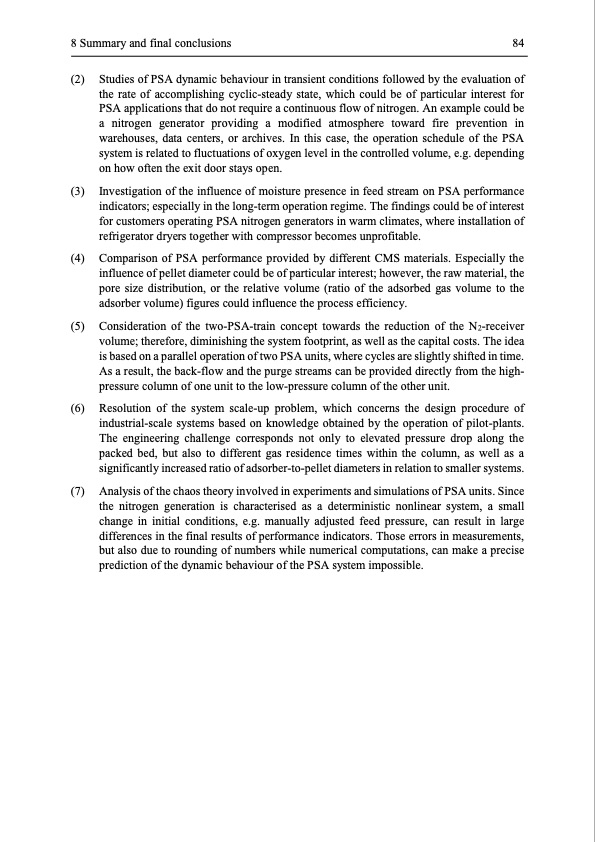
PDF Publication Title:
Text from PDF Page: 097
8 Summary and final conclusions 84 (2) Studies of PSA dynamic behaviour in transient conditions followed by the evaluation of the rate of accomplishing cyclic-steady state, which could be of particular interest for PSA applications that do not require a continuous flow of nitrogen. An example could be a nitrogen generator providing a modified atmosphere toward fire prevention in warehouses, data centers, or archives. In this case, the operation schedule of the PSA system is related to fluctuations of oxygen level in the controlled volume, e.g. depending on how often the exit door stays open. (3) Investigation of the influence of moisture presence in feed stream on PSA performance indicators; especially in the long-term operation regime. The findings could be of interest for customers operating PSA nitrogen generators in warm climates, where installation of refrigerator dryers together with compressor becomes unprofitable. (4) Comparison of PSA performance provided by different CMS materials. Especially the influence of pellet diameter could be of particular interest; however, the raw material, the pore size distribution, or the relative volume (ratio of the adsorbed gas volume to the adsorber volume) figures could influence the process efficiency. (5) Consideration of the two-PSA-train concept towards the reduction of the N2-receiver volume; therefore, diminishing the system footprint, as well as the capital costs. The idea is based on a parallel operation of two PSA units, where cycles are slightly shifted in time. As a result, the back-flow and the purge streams can be provided directly from the high- pressure column of one unit to the low-pressure column of the other unit. (6) Resolution of the system scale-up problem, which concerns the design procedure of industrial-scale systems based on knowledge obtained by the operation of pilot-plants. The engineering challenge corresponds not only to elevated pressure drop along the packed bed, but also to different gas residence times within the column, as well as a significantly increased ratio of adsorber-to-pellet diameters in relation to smaller systems. (7) Analysis of the chaos theory involved in experiments and simulations of PSA units. Since the nitrogen generation is characterised as a deterministic nonlinear system, a small change in initial conditions, e.g. manually adjusted feed pressure, can result in large differences in the final results of performance indicators. Those errors in measurements, but also due to rounding of numbers while numerical computations, can make a precise prediction of the dynamic behaviour of the PSA system impossible.PDF Image | Modelling and Simulation of Twin-Bed Pressure Swing Adsorption Plants

PDF Search Title:
Modelling and Simulation of Twin-Bed Pressure Swing Adsorption PlantsOriginal File Name Searched:
dissertation_marcinek.pdfDIY PDF Search: Google It | Yahoo | Bing
CO2 Organic Rankine Cycle Experimenter Platform The supercritical CO2 phase change system is both a heat pump and organic rankine cycle which can be used for those purposes and as a supercritical extractor for advanced subcritical and supercritical extraction technology. Uses include producing nanoparticles, precious metal CO2 extraction, lithium battery recycling, and other applications... More Info
Heat Pumps CO2 ORC Heat Pump System Platform More Info
| CONTACT TEL: 608-238-6001 Email: greg@infinityturbine.com | RSS | AMP |